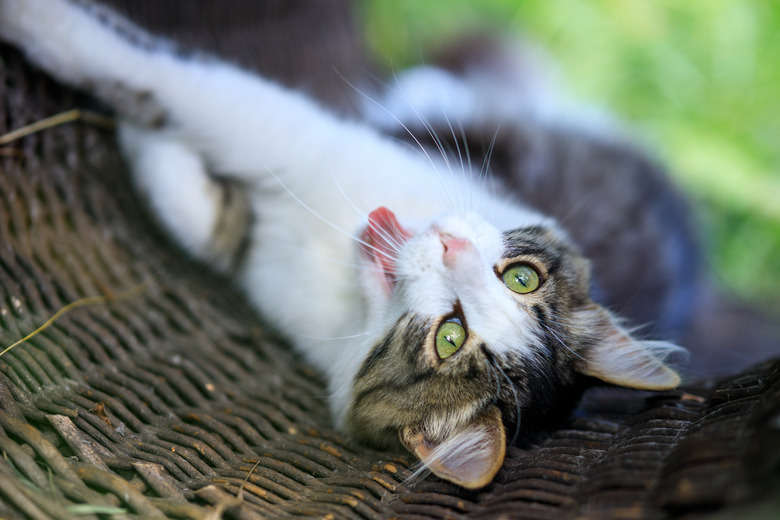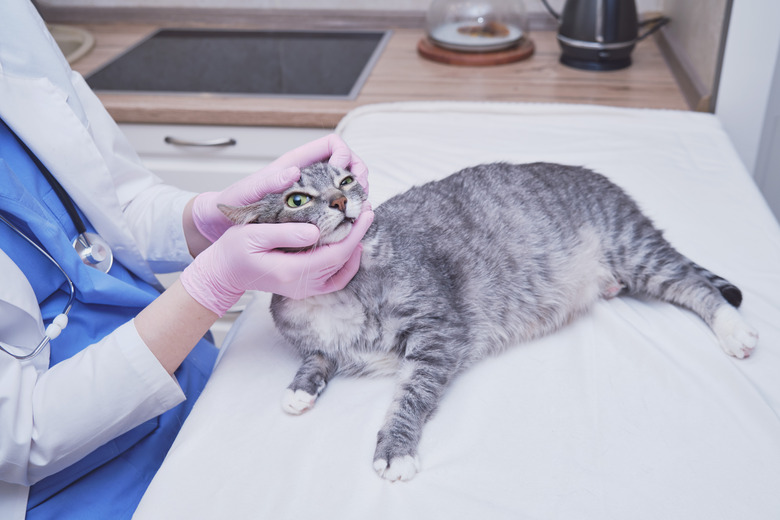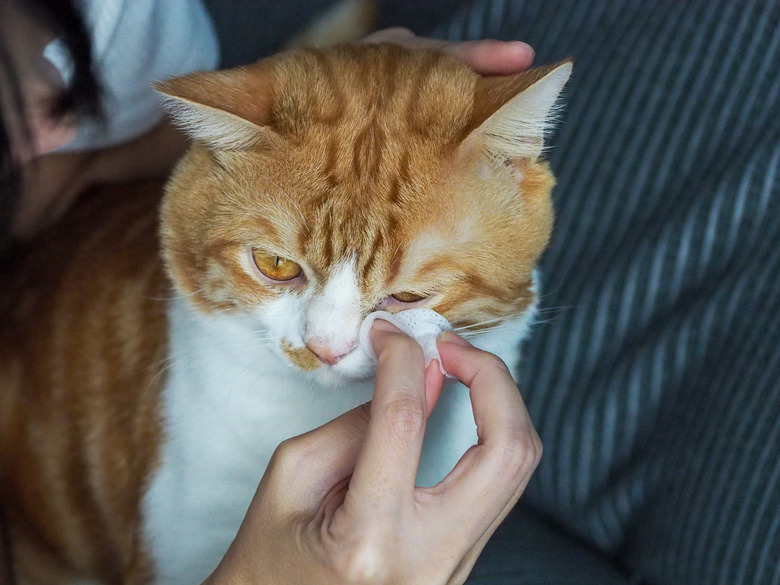Eye Discharge In Cats
It is common for cats to have discharge from one or both eyes. A healthy cat's eyes are very good at washing away any debris or dust in the eye. If your cat has bright, clear eyes and only has small amounts of discharge at specific times of the day, there is unlikely to be anything to worry about. Even a bit of crusty eye gunk can be expected after your cat has been sleeping for a while and doesn't necessarily mean there are eye issues.
If your cat has thick, goopy, or discolored eye discharge and any other symptoms, such as rubbing their eyes, squinting, or sneezing, it is a sign that there may be an underlying cause that you should tell your DVM about. Knowing the causes of eye discharge in cats is essential for anyone who lives with cats.
What is eye discharge in cats?
What is eye discharge in cats?
Eye discharge in cats occurs when fluid or mucus is released from the eye and can be a symptom of eye disease. Although a small amount of daily eye discharge is normal, if it occurs in increasing amounts or becomes thick and goopy, it is a sign that your cat may be ill. If the discharge appears white, yellow, green, or even pink with tinges of blood in it, you should take your cat to see the veterinarian for diagnosis and treatment.
Symptoms of eye discharge in cats
Symptoms of eye discharge in cats
Eye discharge in cats can appear in different forms and can also be accompanied by other symptoms. It can occur in one or both eyes. Knowing these symptoms of an eye condition will ensure you get your cat to the veterinarian before any underlying disease can further develop. Symptoms to look out for include:
- Sticky, discolored mucus in the corner of the eye
- Red or inflamed eyes
- Watery eyes / excessive tearing
- Rubbing or pawing at eyes
- Blinking
- Squinting
- Sensitivity to light
- Sneezing
- Runny nose
- Cloudy or changed appearance of eyes
Common causes of cat eye discharge
Common causes of cat eye discharge
Cat eye discharge can signify disease or injury to the eye. Without early treatment, this can lead to long-term health problems and even loss of sight. The causes of discharge from a cat's eye include:
- Infections: Viral or bacterial infections are common causes of eye discharge in cats. Infections can be caused by eye irritation or viruses, such as feline herpes virus, feline infectious peritonitis, feline calicivirus, or upper respiratory infection.
- Conjunctivitis: Otherwise known as pink eye, conjunctivitis is an inflammation of the conjunctiva, which is the pink membrane lining of the eye. Conjunctivitis has many causes, and while it is usually easy to treat, it can lead to serious complications if not treated early.
- Allergies: Allergies are a very common cause of cat eye discharge. Cats may have allergies to mold, pollen, or household products.
- Blocked tear ducts: Blocked tear ducts can often be caused by the shape of a cat's face, so it is far more common in brachycephalic cats, such as Persians or Himalayans. They can also be caused over time by chronic infections or allergies. Excessive hair around the face can collect debris and contribute to this problem.
- Dry eye: Known as keratoconjunctivitis sicca, dry eye is caused by a lack of tear production. This will result in sore, dry, and inflamed eyes. If left untreated, it will lead to loss of sight.
- Blepharitis: Inflammation of the eyelids is known as blepharitis and can be incredibly uncomfortable for cats. Cats will have some discharge, crusty eyelids, and hair loss around the eyes. It is most commonly caused by entropion when the edges of the eyelid grow inward, and breeds with a flat face or facial folds are more prone to it. Other illnesses, trauma, infections, environmental irritants, and tumors may cause blepharitis in cats.
- Corneal disorders: The cornea is the membrane that creates the surface of the eyeball. When it becomes damaged through injury from foreign objects or illness, it can become eroded or ulcerated. This condition is very painful and can lead to a loss of sight. Cats will blink, squint, and paw at their eyes. Urgent veterinary care is required for a corneal ulcer.
- Uveitis: When internal structures of the eye become inflamed, it is called uveitis. This is a very painful condition, and cats may close their eye completely or resist being touched. The cat's eye may show cloudiness and there will be mucus, pus, and possibly bleeding. This serious condition can be caused by cancer, infections, trauma, high blood pressure, diabetes, or autoimmune disease.
- Glaucoma: When the pressure within a cat's eye increases, it causes glaucoma. The eye may be cloudy or bluish in color and swollen. Because it is painful, your cat may be depressed, squinting, and avoiding contact. Some breeds are predisposed to an anatomical abnormality that can cause glaucoma, but this is rare. Glaucoma is usually caused by an injury or eye disease. Blindness can be caused quickly without veterinary care.
- Foreign body: It is possible that a foreign body can cause irritation and discomfort, leading to eye discharge. A piece of dust or a plant seed may become trapped and lead to discomfort and infection.
- Cancer: Melanoma of the eye can result in a great deal of discomfort for a cat and cause it to change shape or color. If the cat rubs or scratches their eye, this may result in an injury that leads to discharge.
Diagnosing cat eye discharge
Diagnosing cat eye discharge
Cat eye discharge can have many different causes, so your veterinarian will first want to give your cat a thorough physical and ocular examination and talk to you about other symptoms you may have noticed. They will also comprehensively evaluate your cat's eyes.
The veterinarian will look at the surface of the eye (your cat's cornea), eyelids, mucous membranes, and other eye parts using a light or an ophthalmoscope. They may also want to measure eye pressure and can do this with a tonometer. Flushing the tear ducts will indicate an obstruction. To test the rate of tear production, your veterinarian may conduct a tear test. Using a fluorescein stain test will help identify a corneal ulcer or injury.
The veterinarian may wish to take a culture of the eye discharge from your cat for analysis. Other diagnostic tests for your cat's eye problems could include imaging such as ultrasound, X-rays, CAT scan or MRI, and blood tests.
Once your veterinarian diagnoses the cause of your cat's eye discharge, they will recommend treatment and care. If your veterinarian diagnoses a serious eye disease, they will refer you to a veterinary eye specialist.
Treating cat eye discharge
Treating cat eye discharge
The treatment a veterinarian will prescribe will depend on the condition causing the discharge. Antibiotics, eye ointments, anti-inflammatory eye drops, and artificial tears are common treatments for eye infections and injuries. Your veterinarian will treat the cause in cases with an underlying illness.
Cats with eye discharge may require additional treatment, including surgery, fluid support, or immune-suppressing drops. Because eye discharge can be a symptom of many severe illnesses, never attempt to use over-the-counter eye drops or homemade remedies. Always seek veterinary attention for your cat for eye discharge to prevent loss of sight or life-threatening complications.
How to prevent eye discharge in cats
How to prevent eye discharge in cats
While it would be impossible to prevent all illnesses and injuries that would affect a cat's eye and cause discharge, some things can be done to minimize the risks. This starts with good hygiene. Keeping the cat's resting areas and litter tray clean and reducing the risk of allergens in the home can reduce the chance of eye discharge caused by irritation and allergies.
Keep your cat's eyes clean so that discharge doesn't build up. Wipe their eyes with a soft, damp tissue or cotton ball. Use a different tissue or cotton ball for each eye to ensure no infections can be spread.
Good general preventative health care can make a big difference. Your cat should be up to date on all necessary vaccinations and parasite control. Groom your cat regularly and check their eyes for any changes. Make sure you are not keeping too many pets in a small area. Feed your cat a healthy and nutritious diet and visit the veterinarian regularly for checkups.
If you notice anything concerning about your cat's eyes or unusual eye discharge, arrange to take your cat to your veterinarian.
The bottom line
The bottom line
Cat eye discharge may indicate that your cat has an eye injury or other underlying illness that may threaten their eyesight. In some cases, cat eye discharge is a symptom of a life-threatening disease. Although cats can have a small amount of discharge that may appear at a certain time daily, if that ever changes in consistency or color or if the eye discharge is accompanied by any other symptoms, veterinary advice should be sought urgently. Never attempt to treat your cat with over-the-counter eye medications.



